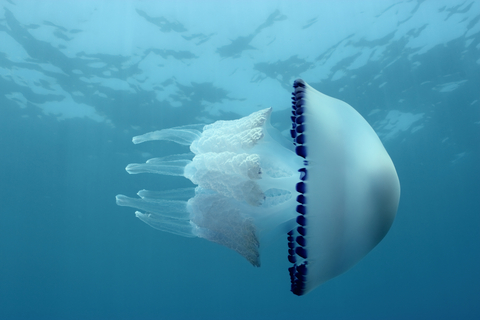
Half a billion years ago, before what is known as the Cambrian explosion when myriads of new species sprouted in the oceans, jellyfish roamed the seas. Jellyfish adapted to sharing their environment with other animals and continued to thrive for hundreds of million years, and they are with us now.
But things are changing for these voracious marine invertebrates. While many animals are endangered and threatened by extinction, jellyfish are once again claiming the seas for themselves. I refer you to Lisa-ann Gershwin’s book, Stung! On Jellyfish Blooms and the Future of the Oceans. The jellyfish are raising havoc.
For an overview, see the article by Tim Flannery in the New Your Review of Books, They’re Taking Over! The title of Flannery’s review says it all: jellyfish are blooming – massively reproducing – throughout the world’s oceans, from pole to pole. Flannery says scientists refer to the jellyfish blooms as “a jellification of the oceans.” And this spells trouble for us. Jellyfish, which range from tiny to huge (hundreds of pounds), have been known to capsize boats, clog cooling systems of nuclear power plants, cause power outages, sting fish (and humans) to death. That’s just a sampling. Hoards of jellyfish destroy and create chaos.
Several possibilities for the proliferation of jellyfish exist. A major cause is warming of the oceans by climate change that extends the ranges of jellyfish and favors their survival over other marine animals. Also, water oxygen levels are depleted by humans dumping nutrients in the oceans, and jellyfish can thrive with lowered dissolved oxygen, while other animals die. In addition, jellyfish have amazing abilities to reproduce and survive. Depending on the species, they can regenerate, self-fertilize and wait out hard times, only to return when conditions improve. This barely touches on the complexity of ocean ecology, the biology of jellyfish and the factors involved in their blooming.
Gershwin is pessimistic. Flannery quotes from the end of her book: “I now sincerely believe that it is only a matter of time before the oceans as we know them and need them to be become very different places indeed. No corral reefs teeming with life. No more mighty whales or wobbling penguins. No lobsters or oysters. Sushi without fish.”
There’s much more to read about jellyfish, their proliferation and the problems that are created by carpets of floating jellyfish everywhere: check it out online. The point of this blog is not to dwell on doom and gloom (I’m an incurable optimist; the glass is always half full for me), but to show the prominent roll jellyfish play in the course of nature. Next week: Jellyfish in art.







Leave A Comment